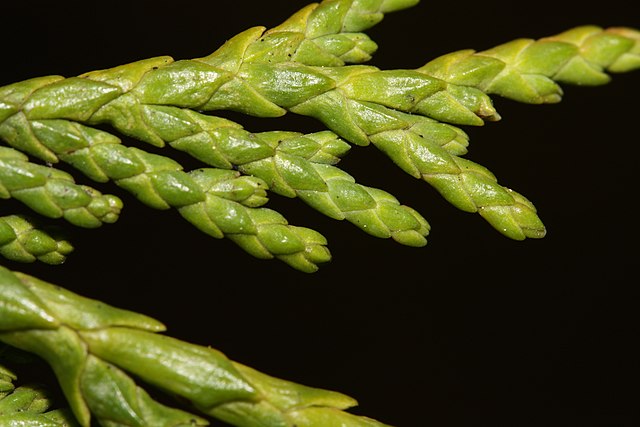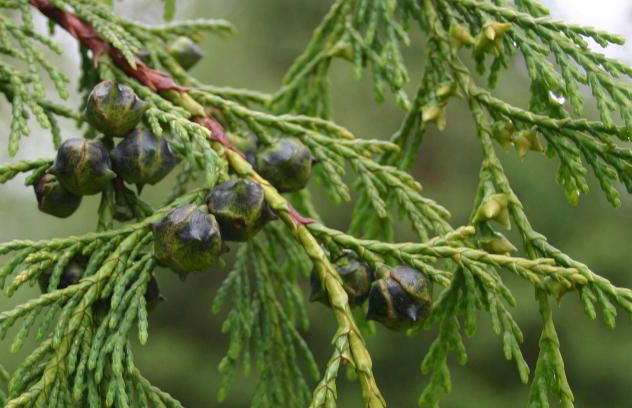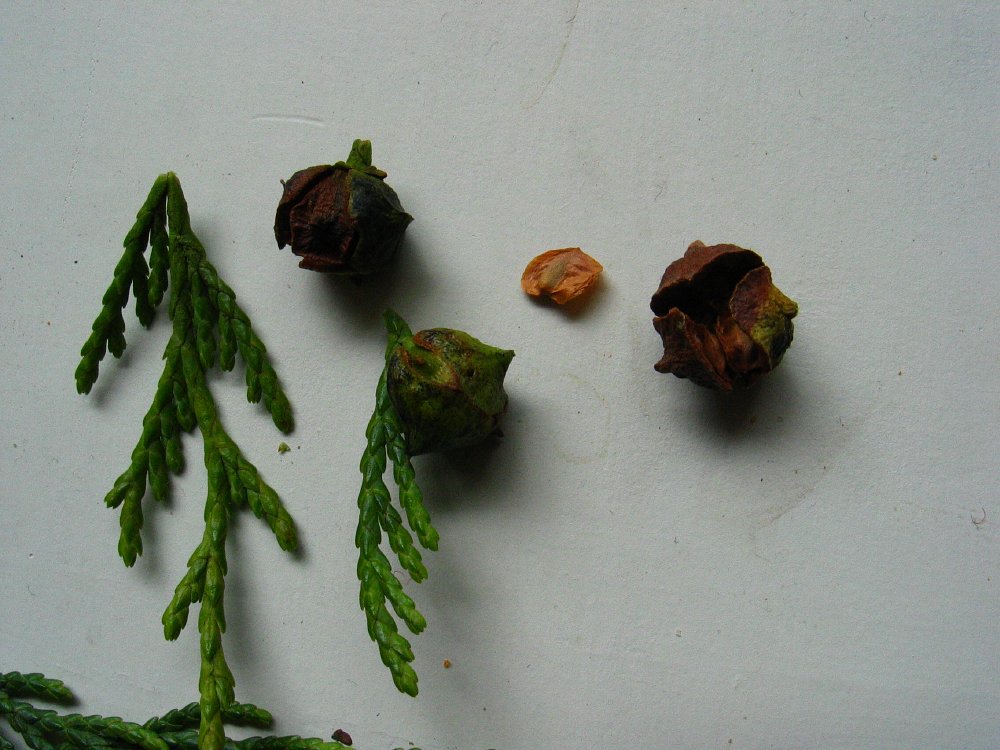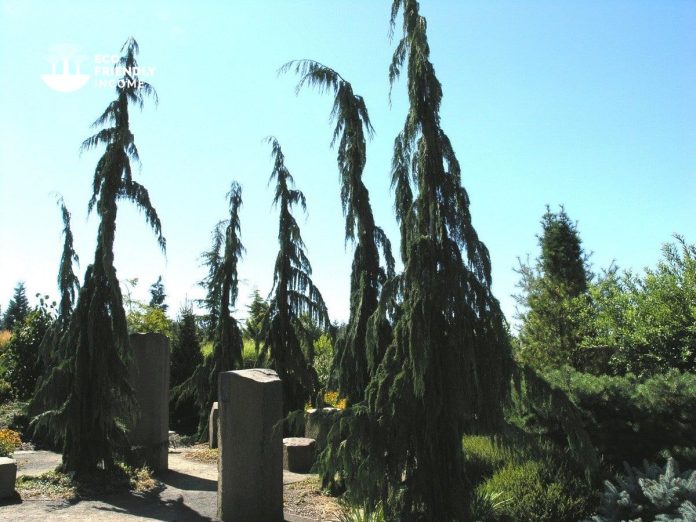A field guide on how to identify and propagate Alaska Cedar (Callitropsis nootkatensis), a hardy coniferous tree that is native to western North America.
How to Identify Alaska Cedar (Callitropsis nootkatensis)
Leaves

Alaska Cedar leaves are lance-shaped, with entire margins, and grow in a scale-like structure on the stem. The leaf stems grow in alternate arrangements.
Cones

Alaska cedar has small blueish-brown, round cones that are distinctive for conifers.
Seeds inside the cones ripen from mid to late September. They usually only shed during dry periods in the fall and early winter.
Habitat
Alaska Cedar (Callitropsis nootkatensis), also known as Nootka cypress, is a species of conifer native to the Pacific Northwest of North America.
It is found in moist, temperate coastal forests at elevations below 1,500 meters. It prefers soils that are nutrient-rich and well-drained.
Alaska Cedar does have companion plants or trees, if you see some of the following trees in the area, there’s a chance you might find an Alaska cedar nearby:
- Douglas-Fir
- Western Hemlock
- Western Red Cedar
- Western White Pine
Nootka cypress is shade tolerant, it is commonly found in coastal hammocks, ravines, and along stream banks. It can also be found in more open habitats, such as rocky outcrops, ridgetops, and coastal bluffs.
Wildlife Value
Alaska Cedar is an important species for a variety of wildlife, providing habitat for birds, mammals, and other animals.
The dense cover of the tree’s foliage provides nesting sites for birds, while the long-lived cones provide sustenance to small mammals and birds.
Additionally, the Alaska Cedar’s bark is highly durable and provides shelter for a variety of wildlife species, including porcupines and squirrels.
It is also an important species in the food chain, as it provides food for a variety of insect species, which in turn provide food for other animals.
Lastly, the Alaska Cedar’s shade helps to protect local waterways, wetlands, and other ecosystems from the effects of climate change.
How to Propagate Alaska Cedar (Callitropsis nootkatensis)

Hardiness Zone: 4-7

Soil Type: Clay, loam, rock, sand.

Water: Normal to High.

Exposure: Full Sun to Partial Shade.
There are two capable techniques of propagation Alaska Cedar, you can grow them from seed or you can take stem cuttings.
- By Seed: Higher rate of success but it takes more time to get an established plant.
- By Cutting: Lower rate of success but provides established plants faster.
Let’s take a look at both techniques:
How to Propagate Alaska Cedar (Callitropsis nootkatensis) by Seed
If you want to grow Alaska Cedar, propagation by seed is a great option. You can harvest the seeds yourself if you know some trees growing nearby.
Alternatively, you can order Alaska Cedar seeds online at PlantasNativa.
How to Harvest the Seed

The best time to harvest Alaska Cedar cones from the trees is either mid-summer or during late winter.
To get the seeds inside the cones, all you have to do is place them in a brown paper bag to dry and they will naturally open up.
Note: Late winter cones will have gone through natural stratification and won’t need to be stratified artificially.
Stratification
Alaska Cedar seeds are particular in their stratification. For a higher chance of success, they need to go through a warm and cold stratification period.
They need at least 60 days of warm stratification followed by 90 days of cold stratification.
Here is the best method to accomplish this:
- Place the seeds in room temperature water for 24 hours, then transfer them into a ziplock bag tagged with the name and date.
- Let them rest like this for 60 days at room temperature (18-24 degrees C).
- Transfer them into your freezer for another 90 days.
Note: Try not to extend the cold stratification longer than 90 or the germination rate will decrease. As for the warm stratification, any longer period will result in mold problems, anything lower will reduce the germination rate.
Plant the seeds in peat moss, and cover the container with plastic to maintain humidity.
Germination will happen sporadically but after this long stratification, success should be about 70%.
How to Propagate Alaska Cedar (Callitropsis nootkatensis) by Cuttings
You can also propagate Alaska cedar if you take semi-hardwood cuttings from young, vigorous trees and force them to root.
First, there are two very important aspects you need to know before taking cuttings.
1. Take your cuttings only from young, healthy plants. Older trees lose their ability to regenerate over the years.
2. Take your cuttings at the right time. Timing is the most important factor in success.
The best time of the year to take stem cuttings from Alaska Cedar is during its dormant period from late fall until very early spring.
Here’s how to do it:
- First, take a close look at branches and identify this season’s growth.
- There’s a color difference between old growth and new growth.
- Now take cuttings from that the season’s growth, but snip just below where the stem goes from green to brown.
- You want the base of each cutting to have some brown to it, next, scuff up the bark about 1 inch from the bases.
- Dip in rooting hormones (1,500ppm IBA) and then plant into your propagation beds.
- Recommended rooting medium is sand, moisture should be kept at all times, and base heat helps hasten rooting.
- Roots are slow and can take longer than 10-12 weeks before repotting.
Recommended rooting medium: Sand with peat mix 90/10.
Tip: You can use bottom heat to speed up the process and also cover it with plastic to retain moisture.
FAQ
Q: How tall do Alaskan Cedars get?
A: Alaskan cedars, which can reach up to 100 feet in height in the wild, have a width of 20 to 30 feet after decades of growth. However, when planted in gardens, they typically grow to a maximum height of 30 feet with a spread that is half of that.
Q: How fast do Alaska Cedars grow?
A: Due to its long lifespan, don’t expect it to grow fast either. It adds no more than 12 inches in height during growth season.
Q: Where is the Nootka Cypress native to?
A: In northwestern America, Nootka Falsecypress is an important timber species. This species is native to the Pacific coastal forests of Alaska and British Columbia, the Cascade Range of Oregon and Washington, and various isolated locations.
Q: How can you tell the difference between Alaska Cedar and Western Red Cedar?
A: The leaves of Alaska Cedar, unlike those of Western Red Cedar, are all similar, causing the leaf-covered twigs to appear four-sided instead of flat. Their cones, which measure 6 to 12 mm in diameter, are round and start off resembling berries, but become woody over time. Mature cones have 4-6 scales and look like an umbrella.

